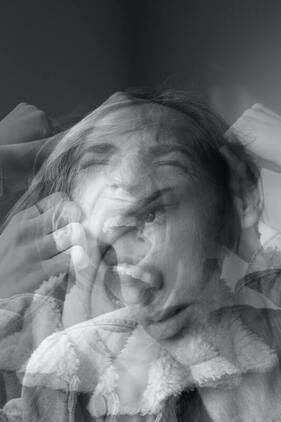|
Learn all about fear and how to overcome it. Put simply, fear is the experience we have when we feel threatened (Adolphs, 2013). Whether the threat is an upcoming performance review at work, the steep slope of a mountain you’ve chosen to ski down, or the sound of footsteps behind you at night, fear is a full-body, stressful experience of anticipating something bad might happen. We usually think of fear as an emotion (Thomson, 1979), but scientists also define fear according to the thoughts, behaviors, and changes in our bodies that happen when we feel fear (Buck, 1984; Ekman, 1977). We often use the words “fear” and “anxiety” as if they are pretty much the same thing. However, researchers and psychologists have distinct definitions for each word. Fear is an immediate and automatic response to something threatening in your environment. If you respond effectively to the fearful situation, you may not fear it as much next time. However, if you don’t resolve or get out of the fearful situation, you learn to worry about that situation happening again. That’s how anxiety develops. In other words, anxiety results from being in fearful situations that you don’t think you can handle (Beck & Emery, 2005; Ohman, 2008). Fear in the BodyWhen something frightens you, your conscious experience of it may be a combination of physical symptoms (more on these in a moment) and fearful thoughts. Psychologists and other scientists, however, think of fear as a response your body makes to something threatening, with the goal of defending you against it (Johnson, 2016). Parts of your brain that focus on detecting threats go on high alert, telling the rest of your body to flood with hormones and prepare you to react effectively (LeDoux, 2003). This high-alert response involves many changes in your body. Fear in the MindPsychologists also measure fear by looking at how frequent, intense, and long-lasting the thoughts are about the threatening event (Rachman et al., 1987). To take an example, most people who are about to have surgery done will have some fearful thoughts regarding negative outcomes. However, if those thoughts come up so frequently or are so difficult to ignore that they make it hard for somebody to go about their daily life, then they may need professional help coping with that fear. Fear in our BehaviorWhen we face something threatening, we try to respond adaptively. All the ways we behave in the face of fear function to help us stay safe (Adolphs, 2013). As you may have heard before, most animals, including humans, respond to frightening circumstances with some version of “fight” (e.g., getting ready to meet the threat head-on), “flight” (e.g., getting ready to run away and avoid the danger), or “freeze” (e.g., shutting down so that the threat may pass you by) (Bracha et al., 2004). Common Symptoms of Fear
Overcoming FearHundreds of studies have shown that the most effective way to treat fear is to expose oneself to fearful situations (McLean et al., 2022). Exposure therapy, as this is called, can look several different ways. People who fear specific situations work with a therapist to face those situations in progressively more fearful ways. For example, somebody who is afraid of spiders might first read about spiders, then look at a picture of a spider, then watch a video of spiders, then sit across the room from a spider in a cage. Another technique, which is more commonly used to support people with PTSD, is to practice intentionally focusing on events that were especially scary (McLean et al., 2022). As people practice writing out and reading out loud the stories of what has happened to them, in a safe and therapeutic context, they begin to have less fear that such a situation will happen again. We can also overcome fear by consciously regulating our bodies. Taking deep breaths, consciously relaxing our muscles, and even imagining ourselves in a less stressful situation can reduce fear. Overall, fear is an essential human emotion, an evolutionary gift designed to keep us safe from harm. Your fears are natural, and they are trying to help you. It’s up to you to decide whether to heed each fear or try to overcome it. I hope this article has helped you understand when and how to do that. References
Here’s what science says about causes, symptoms, and treatment of emotional lability. Do you feel like your emotions swing all over the place? Once you start experiencing emotions, does it feel hard to stop? Or do your emotions feel especially intense? Then you may be experiencing some form of emotional lability. Emotional lability is a rapid and intense change in a person’s emotions or mood, typically inappropriate to the setting (Posner et al., 2014). For example, a person can suddenly start crying uncontrollably because of any strong emotion, even though they do not feel sad, frustrated, or happy. The term originally comes from the Latin word labilis, meaning “transient, fleeting, slippery” (World of Dictionary, n.d.), which highlights the dramatic and frequent shift between emotional experiences. Emotional lability can also be an over-expression of positive emotions, such as enthusiasm or energy, either disproportionate to the event or improper to the circumstance (Posner et al., 2014). One example is when a person suddenly laughs uncontrollably at a funeral. The Diagnostic and Statistical Manual of Mental Disorders, 5th Edition (DSM-5; American Psychiatric Association, 2013) says that emotional lability appears as a symptom in various disorders, including: Borderline Personality Disorder (BPD)Which is a mental illness characterized by unstable moods, impulsive behavior, and problems in relationships. Bipolar Disorder (BP)Which is characterized by episodes of intense mood swings, with depressive lows and manic highs. In Bipolar disorder, emotional lability often lasts longer (e.g., days-weeks; Posner et al., 2014). Substance Use.Which can include alcohol or any illicit drugs. Attention-Deficit/Hyperactivity Disorder (ADHD)A common psychiatric disorder defined by inattention, hyperactivity, and impulsivity. Post-Traumatic Stress Disorder (PTSD)A disorder in which a person struggles to recover after witnessing or experiencing a traumatic event. What are Emotional Lability Symptoms?Extreme emotions and sudden mood shifts.For example, those suffering from emotional lability experience intense feelings that change rapidly and often fluctuate through the day. Improper reactions.If a person laughs uncontrollably at a funeral, it is a sign of emotional lability, as it refers to inappropriate reactions. Difficulty controlling emotions.People who experience emotional lability may have little control of their feelings, which can make it more difficult to stop them. Emotional lability can negatively impact a person’s daily life and these behaviors can be confusing or embarrassing. How to Deal with Emotional LabilityIf you, or someone close to you, are experiencing emotional lability, here are a few things to do to better cope with it (Acquired Brain Injury Outreach Service, 2021). Be aware.It is very important to be aware of what triggers emotional lability and to try to avoid them whenever possible. Some of these triggers include extreme fatigue, stress, or certain social situations or environments. Take care of yourself.By taking care of yourself, both physically and mentally, you may reduce tension and stress. Make sure that you get enough sleep every night, have a balanced diet, and exercise regularly. By doing something that makes you feel better, such as going on a stroll or spending quality time alone, you may increase your overall well-being. Take a break.If you experience lability, it’s ok to take a step back for a few minutes to cope with the emotions. Find a distraction.Sometimes it can be helpful to change the topic or to engage in a different activity to reduce stimulation and regain control of the emotions. Acknowledge the feelings.It’s important to realize that sometimes you can’t control your emotions, and that’s OK. You just must take care of yourself and practice self-compassion. Educate.Other people can be confused or frightened about what they can’t understand. If you feel comfortable, you can let people know what happened. Ask for help.It is important to remember that you are not alone in this. You can talk to your friends or family members, or ask for help from a professional, such as a therapist or psychiatrist. In SumIn summary, emotional lability can be a challenge. By understanding its roots, it may become easier to manage. References
Discover the causes and signs of emotional detachment and strategies to reduce it. Broadly speaking, emotional detachment is the inability or unwillingness to connect with others on an emotional level. Emotional detachment can also mean that people do not engage with their feelings, which can translate into repeatedly being disconnected or disengaged from what other people are feeling. It is like building a wall between yourself and the outside world and not letting it down for anyone. Emotional detachment may interfere with the person’s life, impacting social, emotional, and even work areas. For example, a person might have a hard time creating or keeping a personal relationship, or it might be challenging for them to share their feelings or emotions. Emotional detachment is a complex issue. For some people, being emotionally detached is a coping mechanism—a strategy that is used to protect them from stress or getting hurt. For others, it can be a reaction to trauma, abuse, or unprocessed emotions, which makes the person unable to open about their struggles. Although emotional detachment can be helpful in some situations if used with a clear purpose— such as not caring if people gossip about you—it can have a negative effect if it’s used too much or if you can’t control it. For instance, if you are unable to connect with other people or have a hard time expressing emotions, it might impact your personal relationships. However, it’s important to keep in mind that emotional detachment is not simply a ‘switch’ that can be turned on and off at will. Causes of Emotional DetachmentEmotional detachment can have different causes, such as past neglect or trauma, mental health conditions, or even medications. Some common causes of emotional detachment include: Past Experiences.Exposure to traumatic events and interpersonal trauma in childhood is associated with emotional detachment, but so is psychological trauma in adulthood (Dvir et al., 2014; Foa & Hearst-Ikeda, 1996). Children may also use emotional detachment to cope with a traumatic event. Other Mental Health ConditionsA couple of mental health conditions include emotional detachment. Some of these psychological illnesses include bipolar disorder, depression, personality disorders, and PTSD. MedicationsEmotional detachment might also be a side effect of some medications, including antidepressants such as selective serotonin reuptake inhibitors (SSRIs), which are used to treat major depressive disorders and other psychiatric disorders. Personal ChoiceSome people might choose to detach emotionally to cope with stress, anxiety, or boundaries violations. Signs of Emotional Detachment
In a romantic relationship, some of the emotional detachment signs include (Gunther, 2020): Not Being Available.Your partner might not answer the bids for connection (like requests for something or help needed in an emergency). Even though there will be moments when any partner is less available because of stress, work, or personal issues, being constantly emotionally unavailable or rejecting bids for connection can indicate emotional detachment. Poor CommunicationCommunication is an important skill that needs constant practice, and not all communication is verbal. Poor communication simply means that a partner is not communicating in a way that is clearly understood by the other partner or is expressing disgust or rejection through body language. Reduced Affection.There are many ways to show affection. Learning you and your partners’ love languages is an important step towards building a strong relationship. For example, emotionally detached partners might have a hard time expressing affection or saying, “I love you,” which can negatively impact the relationship. How to Be More Emotionally AttachedHere are some examples of how to let go of emotional detachment and build connections with others: Build a Support System.On your path to understanding your emotions, an important step is to connect with people who support you. Building a support system has many mental and physical health benefits and can be an invaluable help as you begin to gain awareness of your emotions. Practice Mindfulness and Meditation.Mindfulness is an ancient practice that can help you focus on the present moment, which can include your emotional response to an event or how you typically think about emotions in general. Learning how to practice mindfulness and meditation can help you build self-awareness and self-compassion. Practice Being Emotionally Vulnerable.Being vulnerable is an important part of any relationship, as it helps you build an authentic connection, creates a stronger bond, and breaks down emotional walls. Learning how to be vulnerable takes time and patience from you and those around you, so it’s important to have people who support you on this path. Seek Professional Help.Asking for help does not mean you are weak. If emotional detachment is affecting your life, talk to a therapist. A licensed mental health professional can help you work through difficult emotions with science-based interventions and techniques, which can help you reconnect with your emotions. There are numerous types of therapies and interventions that you can choose from, so take the time to find one that works for you. References
Learn about the symptoms, causes, and experience of blunted affect. When somebody isn’t expressing themselves and their emotions in the ways we typically expect, we usually take notice. Although everybody has days when their emotions are higher or lower, people who are experiencing blunted affect stand out because they rarely or never express emotion. Affect is a word psychologists use for the expression of emotions, and blunted, in this case, means dulled, weakened, or slowed down. Typically, this means minimal demonstration of emotion through facial expressions, making less eye contact in conversation, using fewer gestures and other forms of body language to express emotion, and having a flat tone of voice (Padmanabhan & Keshavan, 2016). Psychologists and psychiatrists came up with the definition of blunted affect through careful observation of people experiencing mental health challenges. Specifically, we know from research that blunted affect is common in several groups of psychiatric disorders, including schizophrenia and its related disorders, bipolar disorder, depressive and anxiety disorders, post-traumatic stress disorder, and autism spectrum disorder (Strauss & Cohen, 2017). Although blunted affect may look much the same on the outside, the experience of blunted effect on the inside looks different across these disorders. For some people, blunted affect reflects the fact that they are not experiencing much emotion—they feel numb or empty inside. Other people with blunted affect are experiencing a typical range of emotions, but they are unable to physically demonstrate those emotions in the ways we usually expect. On the outside, blunted affect may involve speech that is monotone or robotic, where the words you would expect to hear emphasized are not. A person with blunted affect will also respond without emotion to events that would evoke emotions in most people, such as learning that one received a promotion or that a loved one was in a car accident. People experiencing blunted affect say that it is even hard for them to force their faces into emotional expressions (Ekman, 2003; Gabay et al., 2015). As you might imagine, being on either side of the equation in a conversation where somebody has blunted affect can be difficult. Human connection relies on the ability to empathize, to feel not only our own emotions but also intuit and feel what others are feeling (Fredrickson, 2013). People with blunted affect have more difficulty doing this (Lee et al., 2014), making it harder for them to build and maintain relationships. What Causes Blunted Affect?Brain imaging studies have shown that the parts of the brain responsible for paying attention to emotions, recognizing facial expressions, and helping us empathize and imagine what other people are thinking, are functioning worse in people with blunted affect (Chuang et al., 2014; Stoodley & Schmahmann, 2010). These findings have led some scientists to believe that impairments in thinking (for example, not recognizing one’s own emotions) are one of the causes of blunted affect (Boden et al., 2021; Strauss & Cohen, 2017). Similarly, other research suggests that blunted affect may also be caused by people’s brains not recognizing cues of emotions, perhaps because their mirror neurons—the parts of our brain that make us feel what another person is feeling—are less active when they are interacting with other people (Lee et al., 2014). However, some research suggests that people with blunted affect only have trouble expressing emotion, not feeling it, which means they may recognize other people’s feelings but not be able to respond to them effectively (Aghevli et al., 2003). In summary, blunted affect is probably caused by a breakdown in the links between the parts of the brain involved in emotions and other parts of the brain, such as the prefrontal cortex (where thinking and decision-making primarily happen) and the motor cortex (which controls physical action). References
Learn how to reduce the impact of alexithymia on your life. All of us sometimes find ourselves at a loss for words, unable to describe our experience in the moment. When you receive unexpected news or have to make a decision with long-term consequences, for example, you may find it hard to say exactly what you’re feeling at the moment. While most of us have moments like these, there are some people who regularly have great difficulty tuning into their internal experience – what emotions and bodily sensations are happening for them. When someone constantly has difficulty identifying or describing their own emotions, they are experiencing alexithymia (Sifneos, 1973). The word alexithymia combines several words from the Greek language – for “no”, lexi for “words”, and thymia for “emotions” – and was created when a Greek doctor started to notice that many of his psychiatric clients had trouble describing their emotions (Sifneos, 1973). What does alexithymia look like? Many people with this condition have trouble explaining why they took certain actions. For example, if I am short-tempered with my partner, or yell at the car in front of me in traffic, I can usually (at least eventually!) identify an emotion by my actions – perhaps anger, or frustration – and an event that triggered the anger – perhaps an argument with a housemate or receiving bad news on the phone. By contrast, people with alexithymia may lash out at somebody but not be able to identify a reason why they yelled, or the feelings associated with it. In their mind, the event sort of just happened, and the connection between an earlier event or an emotion and their behavior is not clear to them. People with alexithymia are also less tuned in to other aspects of their internal experience; for example, they have fewer fantasies and less complex dreams and use their imaginations less than other people (Taylor et al., 1997). Since people with alexithymia are less aware of what’s going on in their own heads, they tend to see the world as being a place where they have little agency and things just happen to them (Taylor et al., 1997). Alexithymia in RelationshipsSimply put, communicating emotions, particularly positive ones, is essential to feeling close to another person (Floyd, 2006). People with alexithymia may avoid relationships because they are not sure how to relate, and then they have difficulty expressing important feelings when they do try to relate (Montebarocci et al., 2004; Qualter et al., 2009). The inability to recognize emotions often extends to other people’s emotions, too, making it hard to develop and maintain close relationships (Hesse & Gibbons, 2019; Humphreys et al., 2009). As a result, they have more difficulty keeping and building connections, especially romantic relationships (Eid & Boucher, 2012; Humphreys et al., 2009). You, like most people, have probably had moments when you thought, “It’s hard to tell my partner what I’m feeling!” The difference between those moments and the experience of people with alexithymia is that you likely knew what you were feeling but weren’t sure how to say it in an effective or tactful way. People with alexithymia, as much as they might want to communicate their feelings and participate in their relationship, struggle to identify and describe their feelings. What Causes Alexithymia?Alexithymia may be caused in part by genetics (Picardi et al., 2011). Alexithymia also seems to develop as a reaction to stressful or traumatic life events (Krystal, 1979; Zeitlin et al., 1993). For many people, these events happened in childhood, but they can happen at any life stage. People who develop alexithymia at an earlier age may have a harder time overcoming it, probably because their brains were still developing at the time, or the events happened again and again over many years (Freybarger, 1977). Let’s think about an example of each of these. Imagine a child growing up in a home where one or both parents rarely talk about emotions, display emotions, or respond effectively when the child shows emotion. Such a child would grow up with very few skills for understanding emotions. On the other hand, imagine that same child growing up in a household with an abusive parent who did not tolerate any displays of emotion, or a neglectful parent that did not meet their basic needs. As you can imagine, a child might cope with either environment by tuning out their emotions as much as possible. Although eliminating alexithymia is difficult and rare, many people have successfully reduced the severity of their alexithymia, improving their quality of life (Cameron et al., 2014). So while for most people with alexithymia, it will always be present for them to some degree, it is possible to overcome alexithymia in the sense of becoming more attuned to one’s emotions, able to connect with other people, and respond to emotions effectively. References
Discover some techniques to overcome sadness. Sadness is an emotional pain that can come from experiences such as losing a loved one, social rejection, or failing to reach a goal. But feeling sad is normal. Everyone has a bad day sometimes, and we all feel sadness at some point in our lives. Sadness is also a healthy emotion. Although it might not be the most comfortable emotion, sadness can help you solicit the social support you need, give you insight, and allow you to process life changes. If you feel sad, you might:
Depression is Different from SadnessAlthough we might use the words “sadness” and “depression” interchangeably and say things like “I’m so depressed today,” these experiences are different. Depression, or major depressive disorder, is a mental condition that negatively affects your daily functioning, has an impact on your body, and even alters your brain. Although feelings of sadness may be associated with depression, the difference between depression and sadness is not only about intensity or degree but also how it negatively affects the person’s life. Tips for Overcoming Sadness“The opposite of depression is not happiness, but vitality,” writes Andrew Solomon in The Noonday Demon, an atlas about depression. If you find yourself feeling sad for longer than usual or with a higher intensity than before, there are a few things you can do: Be aware.Gently ask yourself what is causing you these feelings. It may be work-related, about a friend, or even about something that you didn’t do as you promised. As sadness can also appear when you’re lonely, grieving, or feeling helpless, the first step to feeling better is to identify what caused you to be sad in the first place. Be sad.I know it can seem counterintuitive, but allowing yourself to feel the sadness you’re experiencing, giving it time and space, can be extremely beneficial. If you suppress or deny your emotions, it can lead to actual physical stress on your body and mental health issues. Cry if you feel like it or take a few hours to recharge. Studies echo what philosophers have been saying for decades: tears are cathartic, working like a purifying mechanism that helps you release stress and emotional pain (Newhouse, 2021). Be compassionate.If you validate your sadness, it can help you move through it. Be curious and compassionate about what makes you sad. Figure out what type of comforting you need—for example, you might want to talk to a friend or spend the evening alone and allow yourself to get the self-compassion you need (Hendel, 2020). Practice mindfulness.Mindfulness is all about being present in the moment without any judgment. This lack of judgment allows you to experience and work through the sadness more quickly. Connect.Loneliness and sadness go hand in hand. That’s why reaching out to friends or family might positively affect your mood and strengthen your social connections. Improve your sleep.Sleep and mood are strongly connected. Studies clearly show the significant relation between sleep and depressive symptoms (Nutt, Wilson & Paterson, 2008), so getting more sleep may help improve your sadness. References
Discover guidance for helping to overcome emotional numbness. Do you feel an all-encompassing sense of emptiness? Do you feel distant and cut off from other people? Have you lost interest in things that you used to enjoy? These feelings may describe emotional numbness, a state of generalized disconnection, disinterest, and detachment. Emotional numbness may limit your ability to both express and experience emotions and may cause you to feel disconnected from the world (Flack et al., 2000). These feelings can be present in many psychiatric conditions including depression, schizophrenia, and post-traumatic stress disorder (PTSD). Emotional numbness is distinct from anhedonia, which is a loss or reduction in positive emotions like joy and pleasure. Emotional numbness affects a broad range of emotions including negative ones like fear and sadness (Eskelund et al., 2018). Emotional numbness may produce any of the following symptoms (Palyo et al., 2008):
In a numb state, you may only be able to experience intense emotions like anger and rage. These feelings may emerge at inappropriate times when you are unable to access other emotions. For example, psychiatrist and emotional numbness specialist Hillel Glover describes a persistently numb patient who was attending the funeral of a loved one. This patient exploded into a rage at the funeral, likely because he could not access his feelings of sadness, grief, and mourning. In an especially intense, explosive, and long-lasting rage, you may lose all feelings of care and concern for others and for the consequences of your actions. Afterward, you may become withdrawn and unresponsive for an extended period. You may even experience amnesia and be unable to recall the event. Emotional numbness may cause you to feel hollow, dead, shut down, or with an empty sense of not having any feelings (Litz & Gray, 2002). You may feel a profound sense of emotional withdrawal and a lack of relatedness to others. You may have difficulties falling asleep because lying still intensifies your feelings of “deadness”. These feelings may cause you to crave constant movement. You may self-medicate with alcohol or with illicit drugs to counteract this emptiness and to feel energetic and active. A feeling of profound numbness may cause you to feel that your body is transparent, that other people can literally see through you, or that you can walk through walls because your body has no physical substance. You may also feel disconnected from your own identity. You may wonder who you are. You may adapt to these feelings by creating a self-image or identity with clearly defined visual elements, such as “combat warrior” or “fashionista”. How to Deal with Emotional NumbnessSeveral therapeutic techniques may be effective in helping you overcome your emotional numbness. Cognitive Behavioral Therapy (CBT) is considered the gold standard in treatment for many of the conditions that underlie emotional numbness (Foa & Meadows, 1997). CBT includes a range of talking therapies that address the relationship between thoughts, feelings, and behaviors. Effective CBT may be able to help you identify and address harmful and distorted thinking patterns such as those experienced in a hyperarousal state. CBT may also help you safely confront your fears and anxieties and overcome your emotional numbness. In the absence of systematic treatment under the guidance of a mental health professional, there may be other techniques and procedures that may help you cope with your feelings of emotional numbness. MindfulnessMindfulness is the ability to experience the present moment without judgment (Berceli & Napoli, 2006). When you are mindful, you accept and acknowledge all your thoughts and feelings, even the negative ones. Mindfulness training may decrease symptoms of both hyperarousal and emotional numbness (Stephenson et al., 2017). Being able to ground yourself in the here and now may help you reconnect with the world and overcome your feelings of numbness. Art or Art TherapyCreating artwork or participating in art therapy may help you create a coherent and comprehensible narrative of your emotional numbness and the conditions that may have led to it. You may find it very difficult to use words to express the upsetting emotions and memories that may underlie your emotional numbness. Visual forms of expression such as art may help you process these difficult and upsetting emotions and construct a coherent narrative of any underlying trauma (Collie et al., 2006). Resources
Discover the roots of disgust and how physical and moral disgust impact your life. Disgust has been identified as one of the universal emotions shared by all people (Rozin & Fallon, 1987). It is characterized as feelings of revulsion, of wanting to get away from the offensive object. Your feelings of disgust stop you from eating spoiled food and ensure that you stay away from excrement and other potential sources of disease and infection. But we don’t only feel disgusted in response to physical objects with the potential to make us sick. We often refer to behaviors and actions that we deeply dislike as disgusting. An online search of recent news headlines that feature the word disgusting revealed that racism, police brutality, political maneuvering, opposing media outlets, and stigma about mental health, among other things, were all labeled as disgusting. Do these various actions and ideas all elicit the same visceral feeling that you get when you smell vomit? Or is disgust used in such headlines as a metaphor? The disgust felt in response to moral transgressions may have evolved from the more basic disgust felt in response to physically offensive objects. Paul Rozin, a pioneering researcher in the psychology of disgust, puts it this way: Disgust has evolved from protecting the body to protecting the soul and the social order. Research has found, time and again, that feelings of disgust are often illogical. For example, when presented with two pieces of fudge that you know are edible, tasty, not harmful, and identical to one another in every way except that one is shaped to look like dog feces, you are unlikely to ever choose the feces-shaped fudge. Similarly, you’re unlikely to drink orange juice that has been in contact with a sterilized dead cockroach or to drink apple juice from a clean and unused bedpan. In all these situations, the feelings of disgust induced by vermin, excrement, or urine contaminate the food items, even if you know that the items are perfectly safe and tasty (Haidt et al., 1994). Similarly, exposure to disgusting imagery (e.g., “the worst toilet in Scotland” scene from the movie Trainspotting), reduces the perceived value of nearby items (Lerner et al., 2016). Feelings of disgust can contaminate nearby objects, even when those objects are in no way related to the disgust that you are feeling. Advertising rarely employs disgusting imagery. Other negative emotions, like fear and anger, may drive sales in some situations. However, if potential customers feel disgusted when they see your product, even if your product is the solution to a disgusting problem, they’ll probably value your product less. The contaminating power of disgust is enduring. Would you eat a bowl of your favorite soup after it had been stirred with a “used but thoroughly cleaned” fly swatter? Most people would not. The fly swatter, having been contaminated by exposure to a disgusting squished insect, is forever disgusting. Physical DisgustAt a primitive level, emotions drive you to behave in ways that will ensure your survival. For example, fear drives you to escape a dangerous situation. Disgust drives nausea, vomiting, and other behaviors that either prevent things from entering your mouth or remove things that have already entered your mouth. This suggests that disgust has origins in eating, food, and ingestion. Moral DisgustFrom these origins, disgust has evolved. You can also be disgusted by sexual practices, bad hygiene, and reminders of death or injury. Moreover, you can also feel disgusted by contact with undesirable others and by moral offenses (Tybur et al., 2012). Our sense of disgust expanded from the physical to the moral as we became an increasingly social species (Curtis, 2011). Perhaps because pathogens and parasites transmit within and across groups of people, the emotion of disgust is strongly involved in prejudice, xenophobia, and stigmatization (Olatunji & Sawchuck, 2005). Can Disgust Feel Pleasurable?Interestingly, feelings of disgust can sometimes be experienced as pleasurable, in a phenomenon called benign masochism (Rozin et al., 2013). The popularity of dermatologist Dr. Sandra Lee, better known as Dr. Pimple Popper, attests to the appeal that disgusting experiences can have. The Dr. Pimple Popper YouTube channel features close-up videos of oozing blackheads and cyst removals and has over 7 million subscribers. The experience of watching a minor but very real medical procedure causes you to feel disgusted without having to face any real threat. Our ability to feel that we can withstand such menaces produces a gratifying sense of mastery. As you can see, disgust is a powerful emotion. Disgust keeps you from eating spoiled food and from interacting with objects that may contain disease-causing pathogens. However, this beneficial protective system can become co-opted against people who are different from us. References
Discover how to practice radical acceptance to improve your mental health. There is a famous saying that “Pain is inevitable. Suffering is optional.” It suggests that pain is an inevitable part of life; suffering, however, arises from not accepting the pain. What makes this quote helpful is that it not only discerns between pain and suffering, two concepts we often use interchangeably, but it also recognizes that we have power in the face of challenges. We have the power to accept. Radical acceptance is accepting what is not under your control and embracing what is happening now in a non-judgmental way. When you wholeheartedly and radically accept emotional or physical pain, it can reduce suffering. Marsha Linehan, a leading psychologist who introduced the idea of radical acceptance into Western societies, sums it up: “Radical acceptance rests on letting go of the illusion of control and a willingness to notice and accept things as they are right now, without judging”. It is a “complete and total openness to the facts of reality as they are, without throwing a tantrum and growing angry.” (2021; p. 503). Therapies that include radical acceptance are designed to stop the clients from having reactive behaviors and encourage them to respond to challenging situations skillfully. For example, it has been shown that these therapies can reduce substance use and relapse (Bowen et al., 2012), anxiety (Roemer et al., 2008), suicidality (DeCou et al., 2019), and chronic pain (Hann & McCracken, 2014). However, radical acceptance can be learned and practiced outside of therapy. In fact, this strategy can help people accept themselves wholeheartedly, increase well-being (Kotsu et al., 2018), and have positive weight loss benefits (Lillis et al., 2016). How to Practice Radical AcceptanceHere, you can learn more about steps you can take to develop radical acceptance skills (Taitz 2021). 1. Acknowledge the Present.The most important part is to be mindful of your situation, paying attention to it in a non-judgmental way. However, this does not mean you should accept abusive or manipulative behavior; it just means accepting the reality, whether you like it or not. 2. Ask yourself if you can control or change the situation.If you can’t control what happens, why are you getting angry? It can be painful to acknowledge that you’re not always in control, but it can also be freeing. 3. Let go of judgment.Practicing radical acceptance means letting go of judgment and experiencing things as they are. You can improve this mindfulness skill by practicing meditation and being present in the moment. 4. Let the past be in the past.Remind yourself that the past cannot be changed. The past, no matter if good or bad, happened. 5. Breathe.This may sound simple, but it can be extremely effective. Whenever you are fighting reality, your body may get tense in parts such as the shoulders, face, or stomach. So, take deep breaths for a few moments and focus on them. When you practice watching your breath, you may ground yourself to the present moment and become more relaxed. 6. Be patient.Choose to practice radical acceptance daily and understand that it takes time to master it. 7. Practice.Practice accepting situations so that when bigger challenges come along, you’ll have already developed these skills. Radical acceptance can be a useful skill for improving personal well-being and interpersonal relationships. Hopefully, the information provided here gives you some ideas for how to practice it in your life. References
|
AuthorPamela (Pami) Parker currently serves as a holistic practitioner, coach and teacher. Her intention is to be a compassionate guide to those who choose to experience a healthier, happier and more peaceful way of life. Categories
All
|
Company Details
The Self-Care Cafe is a member of The Conscious Center
Dutch Chamber of Commerce (KvK) Registration #64532593
Taxation (VAT) Number: NL670496157B01
Privacy Policy
The Self-Care Cafe is a member of The Conscious Center
Dutch Chamber of Commerce (KvK) Registration #64532593
Taxation (VAT) Number: NL670496157B01
Privacy Policy









